-
solutinos
-
Hire
Frontend Developer
Backend Developer
-
NodeJS Developer
-
Java Developer
-
Django Developer
-
Spring Boot Developer
-
Python Developer
-
Golang Developer
-
Ruby on Rails Developer
-
Laravel Developer
-
.NET Developer
Technology
-
Flutter Developer
-
React Native Developer
-
Xamarin Developer
-
Kotlin Developer
-
Cross-Platform Developer
-
Swift Developer
-
MongoDB Developer
-
C Developer
-
Smart Contract Developers
Cloud
-
-
Services
Mobile Development
Web Development
- Work
-
Multi Services App
-
Food Delivery App
-
Grocery Delivery App
-
Taxi Cab Booking App
-
Multi Services App
-
OTT Platform APP
-
Social Media APP
-
Freelance Service App
-
Car Rental App
-
Medicine Delivery App
-
Liquor Delivery App
-
Sports Betting App
-
Online Coupon App
-
eLearning App
-
Logistics & Transportation App
-
Courier Delivery App
-
On-Demand Real Estate App
-
E-Wallet APP
-
Online Dating App
-
Handyman Services App
-
-
Process
-
Company
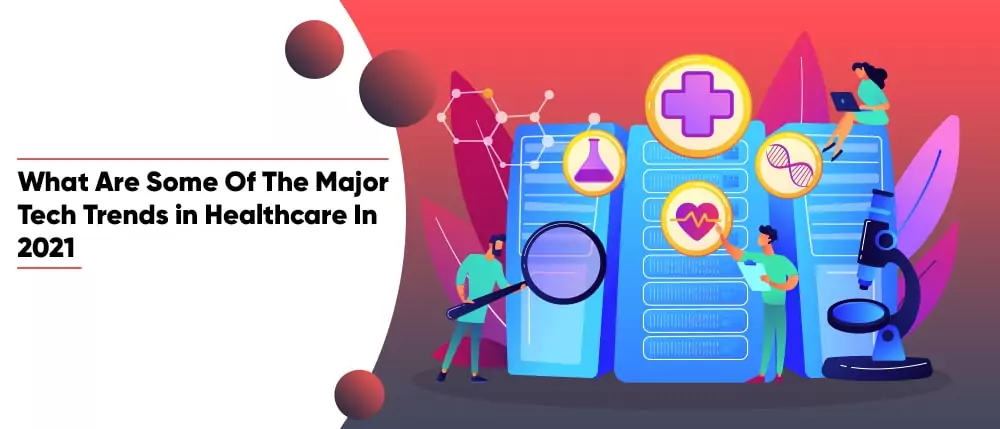
So far, we have seen what a conventional healthcare system has been like and how it could change with the onset of digital transformation. We discussed the anatomy of a digital healthcare system and explored its impact from multiple angles – healthcare insurers, service providers, on-demand healthcare professionals and more.
We have almost covered every aspect of digital healthcare in detail and that leaves us with only a couple of more crucial topics. In today's post, we will cover one such topic that throws light on some of the key trends in the healthcare industry.
By now, we are sure that you have a better understanding of the digital scenario in healthcare from our Digital Transformation in Healthcare series. By the end of the series, you would not only be an authority on this topic but understand what you need to do to go about implementing digital strategies in your healthcare business.
Like from our last post, we already got a lot of responses from people who shared that they would want to get an app for their game-changing healthcare idea developed. We are extremely happy to see our people realizing the importance of tech infrastructure in healthcare.
That’s why our post for today is also aimed at giving you additional insights on some of the technologies immensely influencing the healthcare sector today.
Let’s get started.
Why Is On-Demand Healthcare On the Rise?
It is 2020 and we have to understand and acknowledge the fact that there has been a paradigm shift in the way we have been approaching conventional practices. When was the last time you stood in line to pay for something or simply purchase something?
Don’t remember?
Well, when was the last time you were online to pay for something or simply purchase something? This morning? Yesterday? Last week?
It’s easier to recollect the instances involved in the latter than the former right? That’s where we stand today. We get most things done from our smartphones and other smart devices like tablets, personal computers and more.
We are seekers of instant gratification. Knowledge is available at the click of a button. That favourite t-shirt is just a click away. And even the movie you grew up watching when you were a kid is just a search away.
There has been a psychological change in our consumption behaviours. From waiting for weeks and probably months to listen to that favourite song on the radio or go shopping for an occasion, or simply wait a week for the broadcaster to air the next episode, we have evolved into a generation where we demand things now.
We have express or one-day deliveries to keep up with this need, 24/7 apps to listen to our favourite songs whenever we want to and on-demand entertainment portals that allow us to binge on our favourite shows and complete an entire season in a day.
With our lifestyle undergoing a massive change, what has invariably and involuntarily changed is also our approach towards healthcare.
And why not? If leisure and lifestyle ventures can bring in innovation and meet exceeding consumer demands, why can’t essential services like diagnostic centers, clinics, health insurance providers, healthcare professionals and more make use of technology to pave the way for on-demand healthcare?
That’s exactly what’s happening. Organizations have woken up to our demands and are increasingly resorting to innovation and tech implementation to optimize their healthcare mechanisms, patient care and service deliveries.
We now get on-demand healthcare such as telehealth, m-health, on-demand medicines, on-demand health insurance policies and what not.
The conveniences and features that on-demand healthcare solutions are priceless. For the elderly, for the fragile and for you and me, on-demand healthcare services have been nothing less than a miracle. We have sailed through a pandemic because of on-demand solutions, where people who were skeptical about on-demand healthcare got a taste of convenience and have become loyal patrons.
We are setting the benchmarks for the future and with companies implementing more added features and functionalities in their on-demand healthcare processes, our consumptions would only continue to evolve with more emphasis on patient care, precision diagnostics and optimized healing.
The Inevitability of Big Data in Healthcare

ll the benefits of computers, smartphones, devices and the internet we get to enjoy and experience today is because of the rolling out of one game-changing concept – Big Data. The advent of this tech concept backed by components availability has given rise to everything you and I experience today.
Big Data has shown us the path towards optimized services by letting us leverage on the potential of generating, storing, processing and retrieving tremendous chunks of data new to mankind. It is said that almost 90% of the data ever generated online has been in less than 4 years.
On a daily basis, we generate close to 2.5 quintillion bytes of data every single day. A single look at live internet statistics would show you that there are over 4,703,939,343+ internet users around the world –
- Accessing 1,806,509,485+ websites
- Sending 169,347,999,312+ emails
- Uploading 56,358,467+ Instagram posts
- Watching 4,576,238+ videos on YouTube
- And Googling 4,766,846,971+ searches
- And doing more this very minute as you read this.
Everything is data and all this together is called Big Data, a treasure chest of invaluable information for companies to understand customer behaviour, market insights and more.
As far as the healthcare sector is concerned, this Big Data also involves insights and information on patients, their diseases and ailments, medications, allergies, treatment procedures, invoices and bills, lab test reports and more apart from crucial business insights.
Big Data is big not just in terms of the sheer volume of data generated but the amount of revenue generated as well. It is anticipated that by the year 2023, the Big Data industry will be worth $77bn.
From a healthcare perspective, the applications and benefits of Big Data are aplenty. Through the data generated through electronic health records, social media, online transactions, hospital point of sale systems, websites and more, we can put together relevant data sets and uncover insights that would open up new avenues in treating patients, diagnosing diseases, discovering drugs and more.
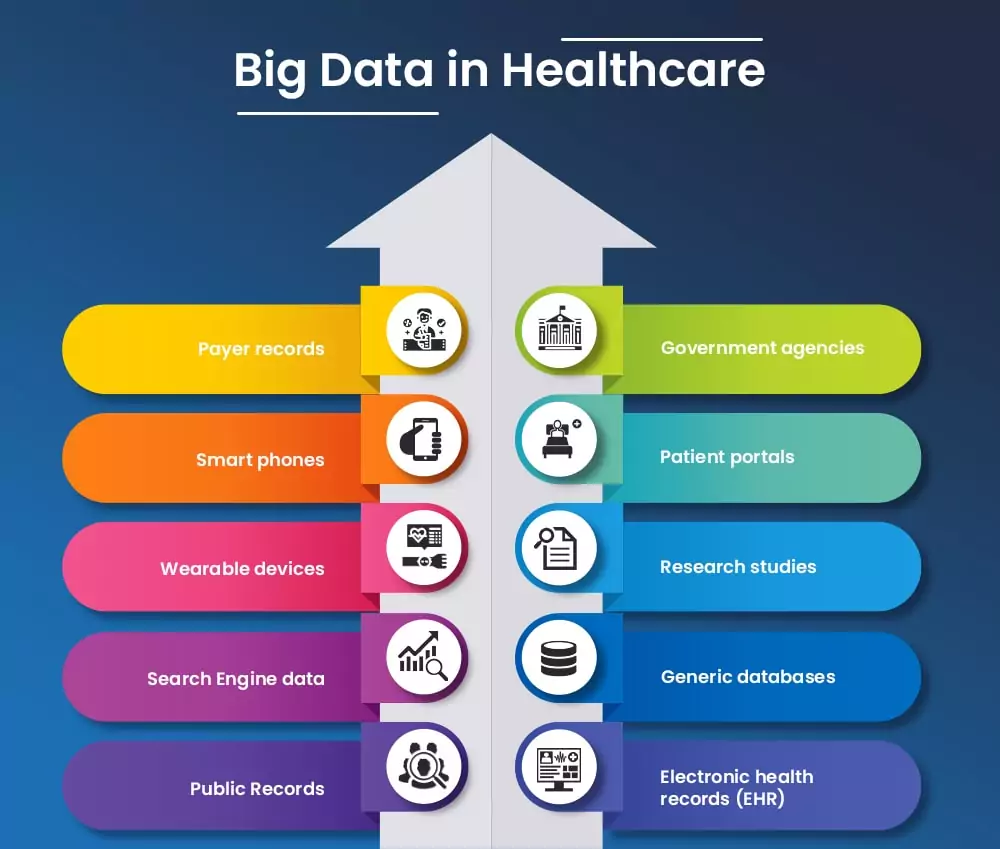
To quickly understand how valuable Big Data is to the healthcare segment, here is a list:
Automated analytics is said to be the norm in the coming months and years and because of this, we would drastically reduce errors in medications and diagnostics. With the help of predictive and prescriptive analytics powered by artificial intelligence, systems could easily pick up and identify discrepancies in diagnoses, prescribed medications, and more and pave the way for optimized healthcare treatments and procedures.
Big Data will also work in tandem with wearable devices and sensors to consistently collect vital health information of users and track patterns. Any abnormalities stemming out of patterns can be immediately notified to concerned health stakeholders as well. More on this later.
Emergency room visits significantly improve expenses and influence staffing, resulting in reduced patient care. Big Data can conveniently solve this concern by allowing doctors and physicians to know in advance the entire medical history and records of the patient so they could immediately start with the relevant treatment procedures. Examinations and tests could be eliminated this way. For those of you who didn’t know, this is already in practice thanks to the work of Almeda Country Hospitals. With their PreManage ED program, the latest test results are made available to doctors for them to immediately initiate treatment procedures.
Big Data coupled with predictive analytics can also help detect and treat cancers. By studying patient recovery rates of treatments from historic data, accurate and the most effective treatments could be studied for optimizations and increase the success rates of future treatment practices. Big Data can also be used to detect cancer in early stages.
Big Data will also help people get notified about the diseases people are more likely to develop because of their genes, lifestyle choices, nature of jobs and more and take corrective measures at the right time.
Big Data will also solve one of the most problematic concerns in healthcare – staffing – through insights invisible to the naked eye. It will allow for better rostering, a more positive employee morale, unbiased wages among genders and more.
This technology will also help in the marketing and promotions of new healthcare centers by letting administrative wings understand market conditions and behaviours better. In healthcare insurance divisions, this is huge.
Virtual Reality For Treatments
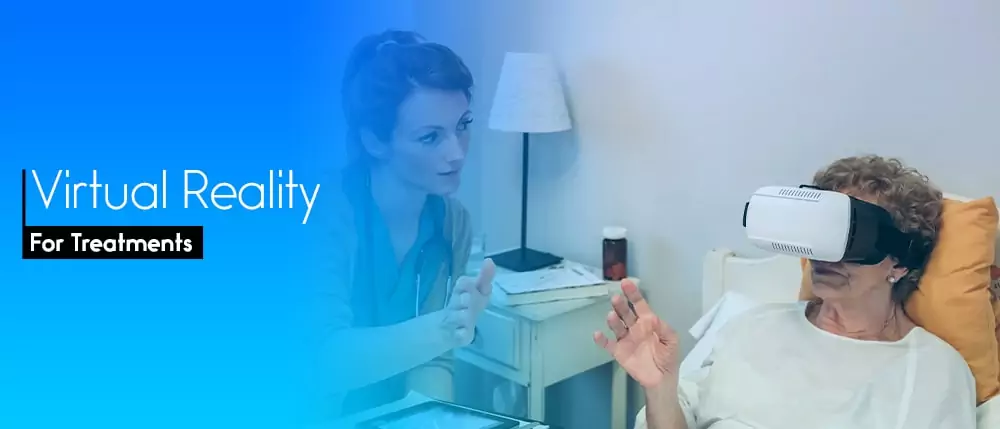
If you have been following our series, you would know that we have always been referring to virtual reality as one of the most underrated technologies out there. The potential of this tech concept is not just futuristic but limitless, too. A lot can be done through the right implementation of virtual reality but unfortunately, this industry is yet to catch up with the tremendous pace concepts like artificial intelligence and Big Data are developing at.
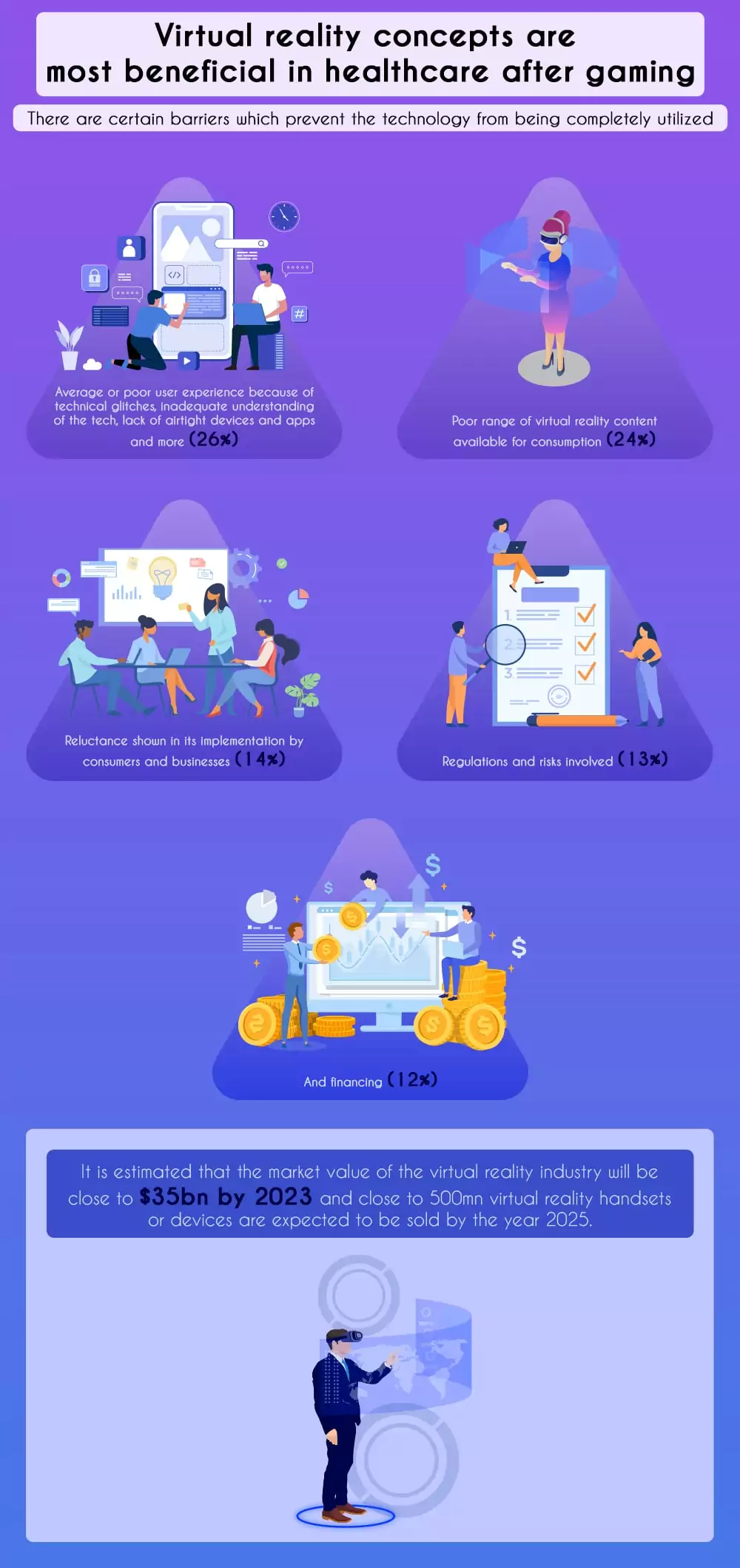
Studies show that virtual reality concepts are most beneficial in healthcare after gaming. However, there are certain barriers which prevent the technology from being completely utilized:
- Average or poor user experience because of technical glitches, inadequate understanding of the tech, lack of airtight devices and apps and more (26%)
- Poor range of virtual reality content available for consumption (24%)
- Reluctance shown in its implementation by consumers and businesses (14%)
- Regulations and risks involved (13%)
- And financing (12%)
Despite these limitations, virtual reality is gradually developing and evolving, especially in the healthcare sector. It is estimated that the market value of the virtual reality industry will be close to $35bn by 2023 and close to 500mn virtual reality handsets or devices are expected to be sold by the year 2025.
When it comes to the healthcare sector, the application of virtual reality is at multiple levels. Like we mentioned in one of our previous posts, there are still several chronic ailments and disorders (physically and mentally) that conventional healthcare practices have failed to cure completely. Experts see the application of virtual reality could make a huge difference and lay the path to recovery for patients.
Reports from CDC reveal that there are over 50m patients in the US struggling with chronic pain. With medications and drugs offering little to no benefits, virtual reality could be the most ideal solutions to them. From treating pain and anxiety to stroke and PTSD, this tech can take care of a myriad of concerns.
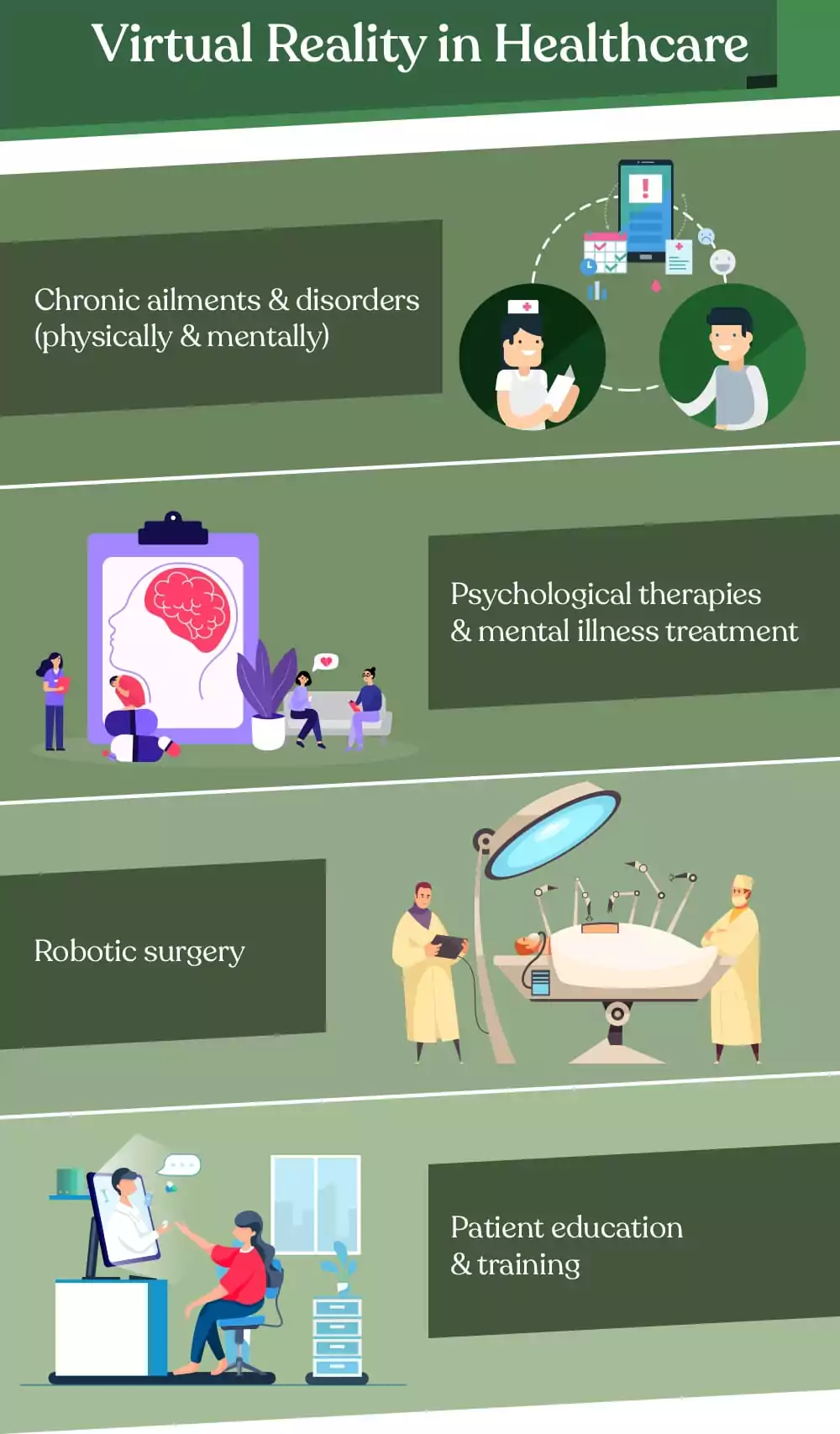
Its application in psychological therapies and mental illness treatment is believed to be priceless, where counsellors and psychologists no longer have to resort to conventional sessions to help their patients overcome trauma, anxiety, panic attacks and more and can use a virtual reality scenario to put them in situations and help them overcome their concerns.
Virtual reality is also being implemented in robotic surgery , where surgeries are performed by doctors through robotic arms for more precision and accuracy, leaving zero chance of errors.
Lastly, virtual reality is also highly beneficial in-patient education and training, where upcoming surgeons and doctors could learn in real-time how crucial surgeries are performed. They could also learn better in 3D rendered models of human bodies, reactions of medications, surgical procedures and more.
Apart from these, virtual reality is used in the diagnosis of diseases, pain management, fitness and therapy and more.
The Rise of Wearable Medical Devices
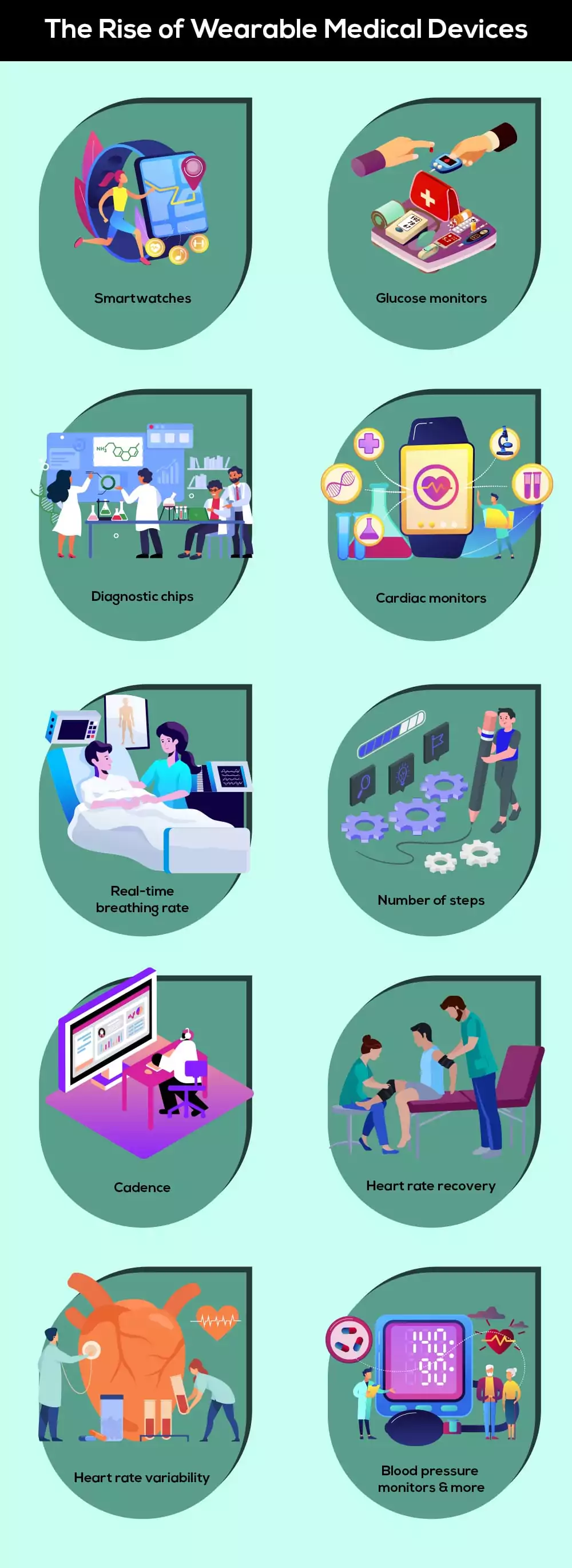
Alongside virtual reality devices, a new and more commercial class of wearable devices are making their presence felt prominent in the market. They are called wearable medical devices and chances are that you already own one of them.
FitBit anyone?
Not just FitBit, there are several wearable medical devices that most of us tend to overlook. Let’s quickly have a glimpse of some of the other common wearable devices:
- Smart watches
- Glucose monitors
- Diagnostic chips
- Cardiac monitors
- Real-time breathing rate
- Number of steps
- Cadence
- Heart rate recovery
- Heart rate variability
- blood pressure monitors and more
The wearable medical devices are either developed by startups and businesses or are rolled out by healthcare companies as part of their patientcare arsenal. These devices pair up with the smartphones of users through mobile applications and consistently serve their designated purposes.
FitBits, for instance, constantly keep an eye out of your vitals and record health details. With the help of artificial intelligence, their apps even recommend lifestyle changes and give visualized details of your daily heart rates, calorie intake and burn details, steps walked, miles covered and more.
There are devices like VitaPatch, which constantly monitor your health and immediately send out notifications and reports to your registered healthcare provider (doctors and nurses) when an anomaly or abnormality arises. The information is in real-time and is accurate for the most precision treatment and diagnosis.
Besides these, upcoming wearable medical devices also include sweat analysis tools that offer details about electrolytes and bodily fluids, devices to detect cancer cells in the bloodstream, wearables that predict Alzheimer’s through walking gaits, smart pacemakers and more.
The growth of this sector has been steady and consistent, which is promising for the future. In 2018, the market value of the wearable medical devices market was around $8mn. But by the year 2023, this is expected to become $27mn.
Apart from patientcare and real-time monitoring and transmission of health details, wearable devices also –
- Support gamification to put healthcare back in the hands of patients
- Personalized healthcare experiences
- Allows health insurance companies to work on their plans and pricing
- Offers insurance incentives to patients who take proactive measures on working on their conditions and health
The Wonders of Artificial Intelligence and Predictive Healthcare
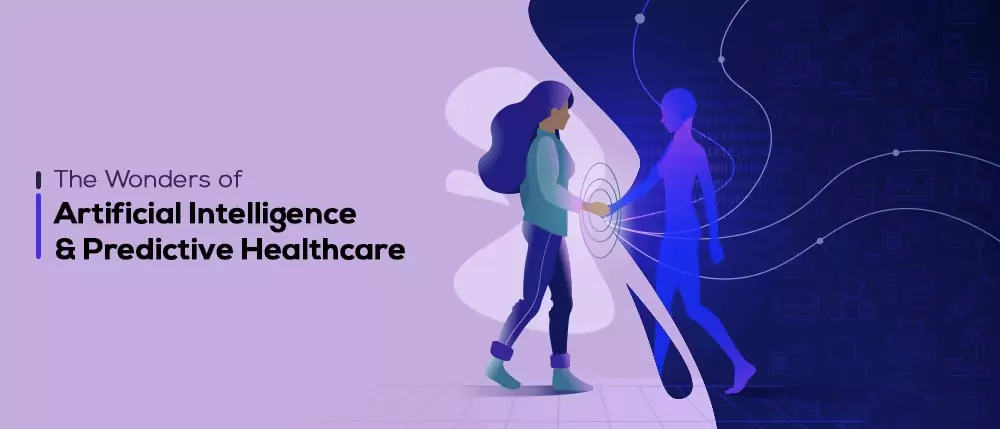
If you noticed, we touched a little upon predictive analytics when we explained Big Data sometime back. In layman terms, it’s best to understand that Big Data, artificial intelligence and predictive analytics are all interconnected and closely associated with each other.
One gives rise to the other and complements the purpose and functionality of the other. The availability of Big Data gives rise to the functionality and powers of artificial intelligence. And the potential of artificial intelligence supports the functionalities of predictive analytics.
In healthcare, the intricacies and association of each is highly invaluable. Artificial intelligence has offered solutions and systems that are priceless to the healthcare industry.
It has helped in the launch and release of chatbots that help all the segments associated with healthcare deliver seamless services. From health insurance companies that have automated bots taking care of customer queries to bots that help in educating users about certain physical conditions and symptoms, artificial intelligence has removed unnecessary manpower from a lot of redundant areas and moved them to spaces where their interventions mattered more.
Artificial intelligence also facilitates precision medicine with its predictive analytics capabilities. It can detect accurately
- when a benign tumor would turn malignant
- the chances of genetic disorders based on DNA studies
- help in the study of mutation in viruses and pathogens
- aid in the discovery of new drugs
- simulate their side effects
- assist in optimized clinical trials
- personalize therapies and treatment procedures and do more.
This tech concept is also being implemented to roll out tangible robots that would assist doctors and physicians in redundant tasks in clinical care such as assessing vitals, temperatures, in escorting patients and more.
Digital imaging is another healthcare branch that artificial intelligence is consistently working to bring about dynamic changes. With the help of algorithms and bots, concerns and deformities that are invisible to the naked eye can be identified, addressed, diagnosed and treated precisely, resulting in holistic healthcare.
Rare diseases like Parkinson's are also being worked for solutions using artificial intelligence by studying brain chemicals and their connection to the disease.
Drug development times can be slashed significantly with the help of artificial intelligence as well. All these together are anticipated to save the healthcare industry close to $150bn in the US by 2026.
Blockchain And Optimized EHR Security
For a lot of us, blockchain is still a puzzling concept. We still associate them with the fintech industry or cryptocurrencies to be more precise. While some of us misinterpret the term, a lot of us don’t want to stress too much on what it is and the changes it can bring about.
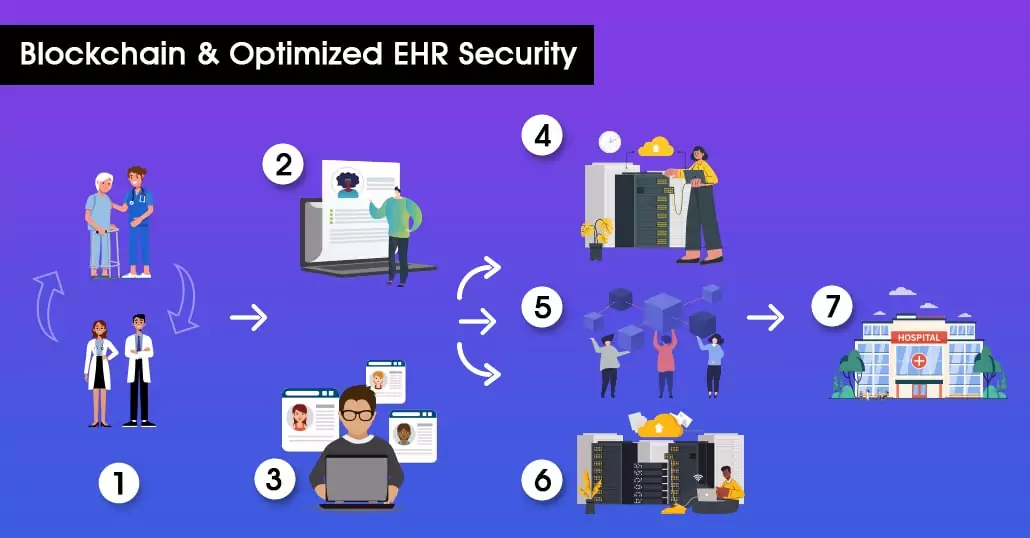
Well, it’s time to learn some new things.
Firstly, blockchain has a very specific and purpose-driven application in healthcare. For those of you who didn’t know, blockchain is a decentralized ledger present across systems in a network. In blockchain, there is no single authority and every member in the network knows about every single interaction or transaction.
This makes it tamper-proof and airtight.
How this could be implemented in healthcare is by making electronic health records stored in blockchain networks. With these digital records containing some of the most confidential data about patients, blockchain would be the most ideal technology to prevent unauthorized access and facilitate interoperability.
Reports reveal that the data from electronic health records have a significant value in the black markets. The implementation of blockchain would only prove to be useful in this case. Apart from making the network fool-proof, blockchain also helps businesses cut down on their expenses and improve their operational accuracy and efficiency.
Blockchain makes systems literally unhackable and one-hundred percent accurate.
Despite these pros, however, the adoption of blockchain technology in healthcare has been quite slow. Similar to virtual reality concepts, companies are hesitant in the development of blockchain systems for their purposes. This is true especially in countries like the US, where regulations and compliances make it tough for blockchain-reliant companies to develop electronic health records.
But it’s not all dark right now as experts indicate that the blockchain in the healthcare market would reach a value of around $890.5mn by the year 2023.
Wrapping Up
So, these were the key technological trends in the healthcare industry. Together, this army of tech concepts and systems is about to completely revolutionize healthcare as we know it and make it more patient-friendly in the coming months.
Ideally, you should be working on getting an app, website or a blockchain system developed for your healthcare idea as timing cannot be more appropriate than now.
With the pandemic reemphasizing the dire need for optimized healthcare services, it’s actually the best time to invest in digital health. So, to turn your ideas into revenue-generating avenues, get in touch with us today.